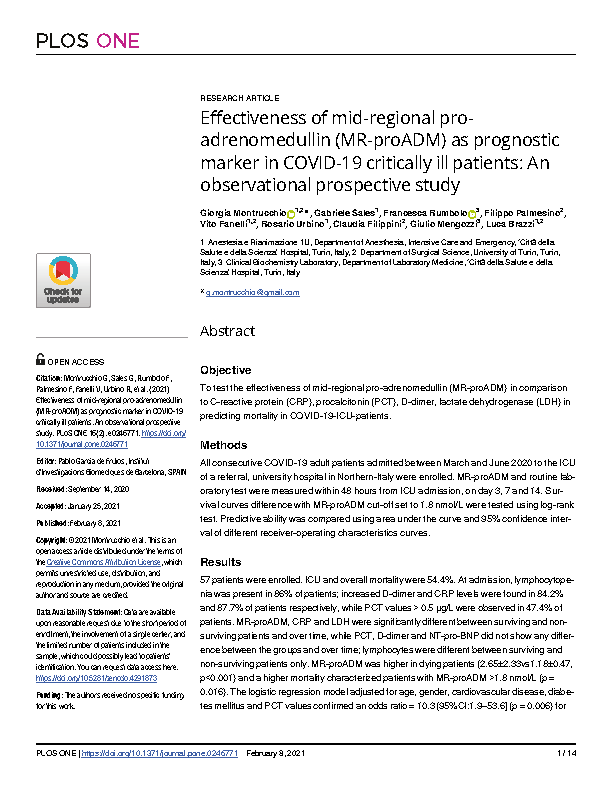04 Mar Effectiveness of mid-regional pro-adrenomedullin (MR-proADM) as prognostic marker in COVID-19 critically ill patients: An observational prospective study.
Montrucchio G, Sales G, Rumbolo F, Palmesino F, Fanelli V, Urbino R, et al.
ABSTRACT
Objective: To test the effectiveness of mid-region proadrenomedullin (MR-proADM) compared to C-reactive protein (CRP), procalcitonin (PCT), D-dimer and lactate dehydrogenase (LDH) in predicting mortality in patients with COVID-19 admitted to the hospital. ICU.
Methods: MR-proADM and routine laboratory parameters were analyzed in all adult patients admitted for COVID-19 to the ICU of a referral university hospital in northern Italy between March and June 2020.
Tests were analyzed within 48 hours of ICU admission and on days 3, 7, and 14.
The difference of survival curves with the cut-off value of MR-proADM set at 1,8 nmol/L was performed using the log-rank test. Predictive ability was compared using the area under the curve and a 95% confidence interval. of different receiver operating characteristic curves.
Results: 57 patients were enrolled:
- ICU and overall mortality were 54,4%.
- On admission, lymphocytopenia was present in 86% of patients
- Increased levels of D-dimer and CRP were found in 84,2% and 87,7% of patients, respectively, while PCT values > 0,5 μg/L were observed in 47,4% of patients.
- MR-proADM, CRP and LDH were significantly different between surviving and non-surviving patients and over time, while PCT, D-dimer and NT-pro-BNP showed no difference between groups and over time.
- Lymphocytes were different between surviving patients and non-surviving patients only.
- MR-proADM was higher in patients who were going to die (2,65 ± 2,33 vs 1,18 ± 0,47, p < 0,001) and higher mortality characterized patients with MR-proADM > 1,8 nmol/ L (p = 0,016):
- The logistic regression model adjusted for age, sex, cardiovascular disease, diabetes mellitus and PCT values confirmed an odds ratio = 10,3 [95% CI: 1,9-53,6] (p = 0,006) for MR-proADM > 1,8 nmol/L and = 22,2 [95% CI: 1,6-316,9] (p = 0,022) for cardiovascular diseases.
Overall, MR-proADM had the best predictive ability
(AUC = 0,85 [95% CI: 0,78-0,90]).
Conclusions: In patients admitted to the ICU for COVID-19, MR-proADM appears to:
- Have consistently higher values in non-survivors.
- Predict mortality more accurately than other biomarkers.
Repetition of measurements can support quick and effective decision making.
Additional studies are necessary to better explain the mechanisms responsible for the increase in MR-proADM in COVID-19 patients.



